Adding Raised Roadbed to the NEW New Boston and Donnels Creek RR, Part 1
If you've been following my articles, you know that we moved in late 2016 and I spent much of 2017 trying to get the next version of my garden railroad installed.
The infrastructure for the upper two layers has been built, and we have run short trains on both of them.
That said, when I started dumping gravel and dirt on the "tables," I realized it was way too easy for gravel to work its way under the track and cause the right of way to be bumpy or otherwise uneven. This was especially true for the upper layer which I can't look down on from some positions. So it was way too easy for an unseen bit of gravel to cause havoc.
I decided to install a "raised roadbed" under the track. It wouldn't need to have plates or posts like an independent raised railroad would - just the "stringers." Those are the long trapezoid-shaped pieces that go together to make a circle and which the track sits on.
This involves getting a few 2"x6"x12' ground-rated boards and cutting them so they fit under the track I laid. In the past, I've done this to build raised railroads that attach to posts, but these boards will just get fastened to the tabletop under the track.
The photos below show examples of raised roadbed I built using 5/4" decking for a clinic (you can't use most 5/4" decking for ground contact applications, so imagine these were 2"x6" ground-rated boards). You can see the trapezoid-shaped "stringers" attached by "plates" that run underneath them. In the present application, the stringers are the only bit I need to cut.
In some ways, it might look like I'm defeating one purpose of building an "outdoor train table" - the ability to change track plans without moving a bunch of dirt and posts. But for these two layers, I'm pretty satisfied with the track where it is, and it will still be easy to move later if I need to.
I don't have to do this, and for a time I thought about putting it off until I got more of the big projects done. The track is very level, after all. If I was putting it on, say, astroturf, I would just leave things as they are.
But once I've done this, I can backfill as much dirt and gravel as I want without worrying about it migrating over onto the track. If they were at an easier height to work, I wouldn't necessarily worry about that. But one of my parameters is that I want to be able to run trains at a moment's notice, even on these high layers, and this will make that far more practical
Also, these "tables" are going to be something like raised flowerboxes. Raising the track 1 1/2" will allow me to put an inch more of dirt down, which will keep the plants that much happier.
This isn't nearly as complicated as it looks. The instructions and templates for cutting the wood pieces easily are on my Simple Raised Railroad article.
- Because the top layer uses track that uses 12 pieces to a circle, I can use this template. I would need about 23 linear feet of 2"x6" boards to make this roadbed.
- Because the middle layer uses track that takes 16 pieces to make a circle, I can use this template. I would need about 40 linear feet of 2"x 6" boards to make this roadbed.
All told, about six 2"x6"x12' boards.
Ordinarily, when I do this, I'm fastening these sections together with "plates" that go underneath, but in this case, I'll fasten them right down to the decking, on top of the vinyl sheeting I'm using to keep all the dirt from sliding through the cracks.
So six 2"x6"x12' boards should do it. I could use 5/4" decking if I could find any locally that was ground rated, since it will be up against damp dirt all the time. It would make a nicer profile, to be honest. But after years of using products that decayed after a few years and needed to be replaced, I don't want to take any chances. (P.S. Some Home Depots stock ground-rated 5/4" decking, just no store anywhere near my house.)
Cutting Roadbed for the Top Layer
As you know, I like using 2"x6"x12' boards because they generally have a better price per foot than shorter lengths. Also, you tend to get less waste when you use longer boards.
The down side is that they're heavy. So I try NOT to buy more than nine or so at one time to avoid blowing the rear shocks out of my minivan.
As it turned out, some of the pieces I bought wound up being used for another project. I started on the top level, since that's the one that would benefit the most.
That loop of track includes:
- Twelve 5'-diameter curved pieces
- Two 4' straightaways
- One 2' straightaway
The curves come first. The photo below shows me using my template for 30 degree curves to mark the first cut.
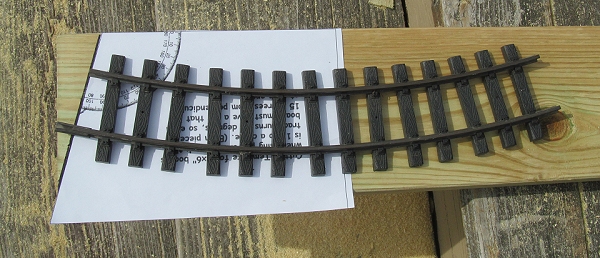
The next photo shows the template "flopped over" to the other end to mark the second cut.
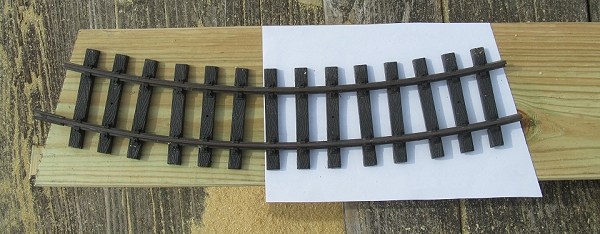
The next photo shows the first stringer as cut out.
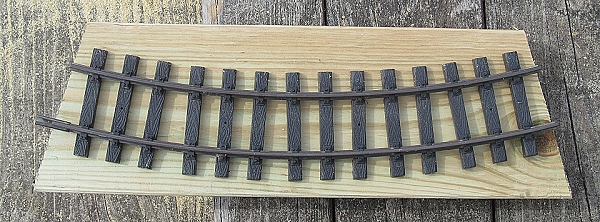
If you're certain the first stringer is very precise, there's no reason you can't just flop it over and mark the next section of the board to cut. However, you need to
- Check each stringer against the one you just cut to make certain it's not far off.
- Keep using your first stringer as your template. If you use the next stringer as the template for the next piece and so on, your stringers will keep getting longer or shorter, depending on how fat your marker is or how much material your saw blade converts to sawdust.
- Line up a few pieces of track over the first few stringers to make certain they're "close enough" to support the track properly. They won't be perfect, but you don't want them so far "off" you need to cut more pieces or some such.
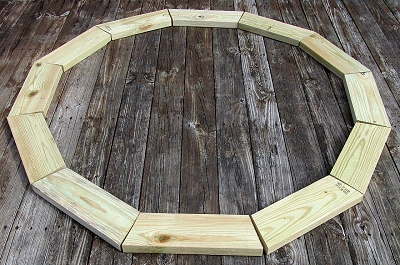
The photo to the right shows the stringers in a circle when I'm done. Of course there will be some straight pieces to cut, but those are easy.
By the way, you'll notice that some of the track pieces don't align exactly in the center when you install them. For example, AristoCraft curves (my favorite track) tend to spring outward a degree or two from where they should be. Once you connect a circle or loop, you hardly notice, but if you just leave an arc of three or four together, they won't curve exactly as much as they "should." That's okay, the important thing is that they're supported.
Installing the Roadbed on the Top Layer
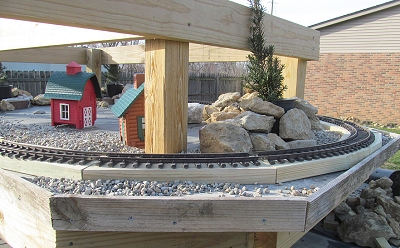 You'll remember that my track was already in place and screwed together. So I did NOT want to take everything apart. Instead I slid the stringers under the curves. You'll remember that my track was already in place and screwed together. So I did NOT want to take everything apart. Instead I slid the stringers under the curves.
At this point, the stringers still stick out in "points" wherever two join. Some of those points bumped up against the edging I had already installed. So I marked and trimmed those corners off before I installed the roadbed there. In the photo to the right, you can see how the part that bumps up against the edging to the right has been trimmed back a little. If I hadn't installed the trim already, I could have just installed the roadbed, then trimmed off that corner.
When I was sure the stringers were aligned where they needed to be, I used 3" deck screws to screw them down on top of the vinyl. Then I cut the long straight pieces I needed.
There's not a problem with screwing through the vinyl, since that has drainage holes anyway.
Though I thought that looked fairly nice, I can't help thinking that taking a little more wood off the other corners would help it look even nicer. Paul Busse's company Applied Imagination uses a very expensive saw that cuts curves to get a very smooth effect (you don't notice because they line the roadbed with tree bark or some such). But my saw doesn't work that way.
The next step will be to move the track aside and set a circular saw to exactly 1.5" depth. When I've finished the upper ROW, I'll proceed to the lower ROW.
 Why am I talking in future tense, when I should have easily finished this project by now. It's because every time my schedule would have permitted me to work outside, it snowed. Why am I talking in future tense, when I should have easily finished this project by now. It's because every time my schedule would have permitted me to work outside, it snowed.
Seriously. Right after I did the work described above, it snowed and it has snowed every few days since. Or else sleeted, or turned bitterly cold, or brought brutal winds. The photo to the right is actually from April 9, a date that - in this part of the country - usually involves shirt-sleeve weather and flowers everywhere. I told Shelia we had February in March, now we're having March in April.
Also, I confess, I borrowed one of the 2"x6" boards I was going to use on the lower level to do another project - hanging corrugated steel in a little nook on the back of our house. That's another project I won't describe in detail, even though the results are looking good so far, because I'm not sure the building codes in everyone else's location would permit some of the approaches I had to take because of a previous owner's screw-ups. If you've ever bought an older home, you know what I mean.
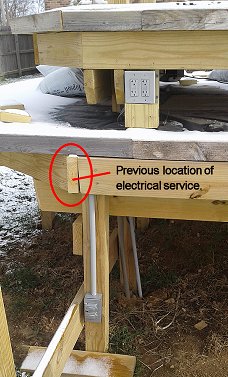 Moving the Electrical Service Moving the Electrical Service
Now that track is installed on two of the layers, it has become apparent that - with the slope of the yard being what it is, the lower layer should NOT be as low as I had planned. If I make it too low, it will be nearly ground level near the east end, not something I want. So it will have to be raised several inches from my original plan.
No, I'm not installing that layer right away, maybe not even this year, but I realized that the board I had installed my electrical outlets on would be in the way. So I moved the outlets up a little higher and removed the board they were mounted on. (Imagine the board that is circled in the photo to the left sticking out several inches.) I also ran an additional line a little lower so I would have easy access later, once the "main" outlets were a little more blocked in.
If you've just dialed in, let me fill in some blanks. A huge in-ground swimming pool used to be located near where the railroad is going in. When I had the back yard regraded to fix the problems caused by a previous owner who "filled in" the pool with construction waste, the Bobcat driver pulled the ends of two conduits out of the ground. Testing carefully, I realized that one contained a 110v line and the other contained a 240v line (for the pool heater). I converted the 240v line to 110V, so the two GFI-protected outlets you see side by side are actually feeding two separate lines. They will be protected from the weather when I build the shed, but in the meantime, they're safe enough, because they're rated for this kind of installation.
Again, I'm not publishing details on my electrical projects, because I don't want to get sued if someone attempts to follow my instructions and electrocutes themselves or sets their train shed on fire. But I will say that all of the circuits are GFI protected, all wiring is outdoor-rated, and all exposed wiring is in appropriate conduits.
What's Next?
This year's plans still include:
- Other Trim Bits - Some additional wood bits that will keep the dirt in its place.
- Dirt, Plants, and Trees
- Starting the Waterfall - It won't be finished entirely until I build the lower, outer layer, but I want to get the upper part going.
- Shed Floor - Even though I'm not building the shed right away, I want to build the floor part to give me a better place to stand when getting trains on and off the track.
Conclusion
As anxious as I am to get onto the really big tasks, I think a year of getting the bits I put together so far under control will be a better use of my time. Not to mention that there are several big projects I need to do on the house we moved into. It's time to "consolidate gains" versus "breaking new ground," I think. And if I get these projects done, they will be giving me something of a head start on either of the "big projects" I have planned.
As I type this, our weekends have still been cold or wet, or both, so even getting small tasks done outside is, shall we say, interesting. So we'll see how it goes. And of course, as soon as I publish this, I will think of several more tweaks for every project I'm even imagining. We'll see
That will be another article. And maybe another year. . . .
As always, if I've helped you get any ideas at all for your next garden railroad construction, I will consider the time it took to document all of this time well spent.
Best of luck, all,
Enjoy your hobbies, and especially enjoy any time you can spend with your family in the coming season. Paul
 Proceed to "Adding Raised Roadbed to the NEW New Boston and Donnels Creek, Part 2 - Trimming the corners off the roadbed on the upper layer and cutting the pieces that will support the curves on the middle layer. We need to get the upper two tiers of the pond installed before we totally complete this step, so the article doesn't show the finished product. You'll see it later as part of other articles. Proceed to "Adding Raised Roadbed to the NEW New Boston and Donnels Creek, Part 2 - Trimming the corners off the roadbed on the upper layer and cutting the pieces that will support the curves on the middle layer. We need to get the upper two tiers of the pond installed before we totally complete this step, so the article doesn't show the finished product. You'll see it later as part of other articles.
 Return to "2018: Springing into Spring on the NEW New Boston & Donnels Creek RR." - Sorting out our priorities for the spring and summer of 2018. There a lot of little chores we really should get done before we start on the next big addition. Click to see our plans as of February 27, 2018. Return to "2018: Springing into Spring on the NEW New Boston & Donnels Creek RR." - Sorting out our priorities for the spring and summer of 2018. There a lot of little chores we really should get done before we start on the next big addition. Click to see our plans as of February 27, 2018.
Click on the photo to see our status as of February 20, 2018
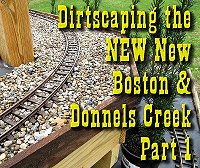 Return to "Dirtscaping the NEW New Boston and Donnels Creek RR, Part 1. - Putting edging around the existing "layers" of the new railroad, and beginning to add gravel and rocks. There were a few test runs, but we got stopped early by bad weather before we could dump the rest of the rocks, gravel, and dirt, much less plant the plants we hoped to get in before snowfall. Return to "Dirtscaping the NEW New Boston and Donnels Creek RR, Part 1. - Putting edging around the existing "layers" of the new railroad, and beginning to add gravel and rocks. There were a few test runs, but we got stopped early by bad weather before we could dump the rest of the rocks, gravel, and dirt, much less plant the plants we hoped to get in before snowfall.
Click on the photo to see our status as of November 21, 2017
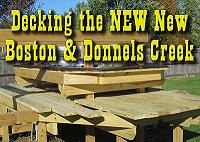 Return to "Decking the NEW New Boston and Donnels Creek RR - Decking the 'middle layer' of our proposed three-tier outdoor railroad. Prepping more track, laying out track and decking to make certain we have measurements correct, installing most of the remaining decking for this layer. Return to "Decking the NEW New Boston and Donnels Creek RR - Decking the 'middle layer' of our proposed three-tier outdoor railroad. Prepping more track, laying out track and decking to make certain we have measurements correct, installing most of the remaining decking for this layer.
Click on the photo to see our status as of October 25, 2017
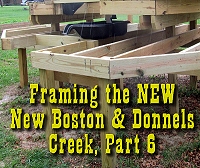 Return to "Framing the NEW New Boston and Donnels Creek RR, Part 6" - Modifying and finishing the framing on the second layer, cantilevering, using R3 track versus all other pre-curved track formats, finalizing the track plan, why painting the track makes old and new track blend better, and more. This will be the last bit of "framing" in 2017, and it worked out well, considering. Return to "Framing the NEW New Boston and Donnels Creek RR, Part 6" - Modifying and finishing the framing on the second layer, cantilevering, using R3 track versus all other pre-curved track formats, finalizing the track plan, why painting the track makes old and new track blend better, and more. This will be the last bit of "framing" in 2017, and it worked out well, considering.
Click on the photo to see our status as of October 15, 2017
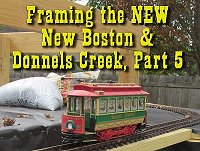 Return to "Framing the NEW New Boston and Donnels Creek RR, Part 5" - Spreading the billboard-sourced vinyl underlayment on the top layer. Prepping used Aristo track for (hopefully) many more years of service. Laying the first loop of track, attaching power wires with spade terminals, and testing conductivity with a Bachmann streetcar. Return to "Framing the NEW New Boston and Donnels Creek RR, Part 5" - Spreading the billboard-sourced vinyl underlayment on the top layer. Prepping used Aristo track for (hopefully) many more years of service. Laying the first loop of track, attaching power wires with spade terminals, and testing conductivity with a Bachmann streetcar.
Click on the photo to see our status as of October, 10, 2017
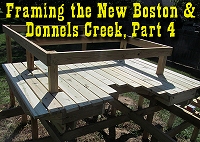 Return to "Framing the NEW New Boston and Donnels Creek RR, Part 4" - Planning and running the decking for the top layer, testing the track plan, checking clearances, prepping used track with new railjoiners, examining the vinyl I ordered to go over the decking, and more. Return to "Framing the NEW New Boston and Donnels Creek RR, Part 4" - Planning and running the decking for the top layer, testing the track plan, checking clearances, prepping used track with new railjoiners, examining the vinyl I ordered to go over the decking, and more.
Click on the photo to see our status as of September 26, 2017
 Return to "Framing the NEW New Boston and Donnels Creek RR, Part 3" -
Getting the frame finished on the top layer, ordering other things I'd need eventually, deciding on materials for the decking on the top layer (at least). Return to "Framing the NEW New Boston and Donnels Creek RR, Part 3" -
Getting the frame finished on the top layer, ordering other things I'd need eventually, deciding on materials for the decking on the top layer (at least).
Click on the photo to see our status as of September 17, 2017
 Return to "Framing the NEW New Boston and Donnels Creek RR, Part 2" -
Once I had the overall frame relatively solid, I hooked up the underground power lines to two GFI plugs that should be in easy reach once everything is finished. I also decided to frame out the top railroad layer while I could still access the center of the railroad easily. Because I was running out of vertical space, I reconfigured that layer. Then after I got the "core" pieces on, I changed my plan again. But the whole thing is getting easier and easier to visualize, and is getting closer to complete with every board I cut and fasten on. Return to "Framing the NEW New Boston and Donnels Creek RR, Part 2" -
Once I had the overall frame relatively solid, I hooked up the underground power lines to two GFI plugs that should be in easy reach once everything is finished. I also decided to frame out the top railroad layer while I could still access the center of the railroad easily. Because I was running out of vertical space, I reconfigured that layer. Then after I got the "core" pieces on, I changed my plan again. But the whole thing is getting easier and easier to visualize, and is getting closer to complete with every board I cut and fasten on.
Click on the photo to see our status as of September 7, 2017
 Return to "Framing the NEW New Boston and Donnels Creek RR, Part 1" -
Once I started dropping posts in the holes and screwing things together, I didn't want to stop before I had the basic frame built (for one thing, the wood warps less once it's fastened in place). Now the folks driving down the street past our house (we're on a corner lot) probably wonder if I'm building an elaborate chicken coop, but that's fine with me. I still need to make a few more lumber runs and do a lot more cutting and sawing, but having the basic frame in place should make the next bits a lot easier. Return to "Framing the NEW New Boston and Donnels Creek RR, Part 1" -
Once I started dropping posts in the holes and screwing things together, I didn't want to stop before I had the basic frame built (for one thing, the wood warps less once it's fastened in place). Now the folks driving down the street past our house (we're on a corner lot) probably wonder if I'm building an elaborate chicken coop, but that's fine with me. I still need to make a few more lumber runs and do a lot more cutting and sawing, but having the basic frame in place should make the next bits a lot easier.
Click on the photo to see our status as of August 10, 2017
 Return to "Breaking Ground on the NEW New Boston and Donnels Creek" -
Okay, in case you wondered if we'd ever get started on the thing, we broke ground in July, using a manual post-hole digger. Well two manual post-hole diggers. But by the end of this article, we're ready for the posts to start going in. Return to "Breaking Ground on the NEW New Boston and Donnels Creek" -
Okay, in case you wondered if we'd ever get started on the thing, we broke ground in July, using a manual post-hole digger. Well two manual post-hole diggers. But by the end of this article, we're ready for the posts to start going in.
Click on the photo to see our status as of the end of July, 2017
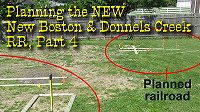 Return to "Planning the NEW New Boston and Donnels Creek, Part 4" -
Well, the rented post-hole digger fell through, so we dug our vegetable garden with a manual post-hole digger (the scissors kind). In addition, I stake out where the railroad was going to be. Twice. And tweaked the plans again. Sorry about the redo's, but sometimes just walking around the yard trying to visualize things makes me reconsider something that seemed "settled" only a few days before. Return to "Planning the NEW New Boston and Donnels Creek, Part 4" -
Well, the rented post-hole digger fell through, so we dug our vegetable garden with a manual post-hole digger (the scissors kind). In addition, I stake out where the railroad was going to be. Twice. And tweaked the plans again. Sorry about the redo's, but sometimes just walking around the yard trying to visualize things makes me reconsider something that seemed "settled" only a few days before.
Click on the photo to see what we were considering as of late May, 2017
 Return to "Planning the NEW New Boston and Donnels Creek, Part 3" -
We have still not broken ground. In part because we plan to rent a post-hole digger and dig the post holes for our raised vegetable garden and the first phase of the garden railroad at the same time, and we don't have enough lumber on hand yet. (If we didn't break it down into multiple trips, we'd be blowing out the shocks on our minivan.) In the meantime, we used a line level to see if the slope of the back yard was as bad as we thought it was (it's worse), and we did other site preparation, including planting a whole bunch of spruce tree seedlings to eventually give us some privacy in our side and back yard. Plus, I'm still wavering a little on the "where-to-start-first" issue. Return to "Planning the NEW New Boston and Donnels Creek, Part 3" -
We have still not broken ground. In part because we plan to rent a post-hole digger and dig the post holes for our raised vegetable garden and the first phase of the garden railroad at the same time, and we don't have enough lumber on hand yet. (If we didn't break it down into multiple trips, we'd be blowing out the shocks on our minivan.) In the meantime, we used a line level to see if the slope of the back yard was as bad as we thought it was (it's worse), and we did other site preparation, including planting a whole bunch of spruce tree seedlings to eventually give us some privacy in our side and back yard. Plus, I'm still wavering a little on the "where-to-start-first" issue.
Click on the photo to see what we were considering as of late April, 2017
 Return to "Planning the NEW New Boston and Donnels Creek, Part 2" -
More plans. We've moved on from the 2"x6" roadbed-on-posts to a sort of "train-table-outside" plan. Our goals include low-maintenance, high interest, and high reliability. We're also trying to get around having a thousand dollars' worth of dirt hauled into the back yard. If you want to get some idea of what our planning process looks like, reading these through in sequence may help. Or it may drive you crazy. Return to "Planning the NEW New Boston and Donnels Creek, Part 2" -
More plans. We've moved on from the 2"x6" roadbed-on-posts to a sort of "train-table-outside" plan. Our goals include low-maintenance, high interest, and high reliability. We're also trying to get around having a thousand dollars' worth of dirt hauled into the back yard. If you want to get some idea of what our planning process looks like, reading these through in sequence may help. Or it may drive you crazy.
Click on the photo to see what we were considering in early April, 2017
 Return to "Planning the NEW New Boston and Donnels Creek, Part 1" -
If you're subscribed to our newsletter, you know that we moved just after Thanksgiving in 2016, leaving behind most of the track, a few of the bird feeders, and one Bachmann train set for the new owners. We also left behind a high-maintenance garden that we do not intend to replicate at the new place. This is the first chapter of a new chapter in our lives, which we hope will include a lot of "lessons learned." But first, some serious landscaping had to take place. Return to "Planning the NEW New Boston and Donnels Creek, Part 1" -
If you're subscribed to our newsletter, you know that we moved just after Thanksgiving in 2016, leaving behind most of the track, a few of the bird feeders, and one Bachmann train set for the new owners. We also left behind a high-maintenance garden that we do not intend to replicate at the new place. This is the first chapter of a new chapter in our lives, which we hope will include a lot of "lessons learned." But first, some serious landscaping had to take place.
Click on the photo to see what we were considering in March, 2017
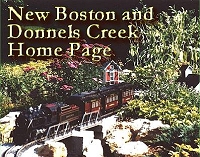 Return to the New Boston and Donnels Creek RR Page - This is the page describing Paul Race's progress and frequent rework on his own garden railroad, started on a shoe-string budget in 1998, later expanded, and later refurbished several times as issues arose. Issues that Paul hopes to avoid by building the next iteration above ground. Return to the New Boston and Donnels Creek RR Page - This is the page describing Paul Race's progress and frequent rework on his own garden railroad, started on a shoe-string budget in 1998, later expanded, and later refurbished several times as issues arose. Issues that Paul hopes to avoid by building the next iteration above ground.
Click on the photo to see the home page of Paul's railroad.
 Return to Family Garden Trains' Home Page - The home page with links to all the other stuff, including design guidelines, construction techniques, structure tips, free graphics, and more. Return to Family Garden Trains' Home Page - The home page with links to all the other stuff, including design guidelines, construction techniques, structure tips, free graphics, and more.
|

























 You'll remember that my track was already in place and screwed together. So I did NOT want to take everything apart. Instead I slid the stringers under the curves.
You'll remember that my track was already in place and screwed together. So I did NOT want to take everything apart. Instead I slid the stringers under the curves.















































